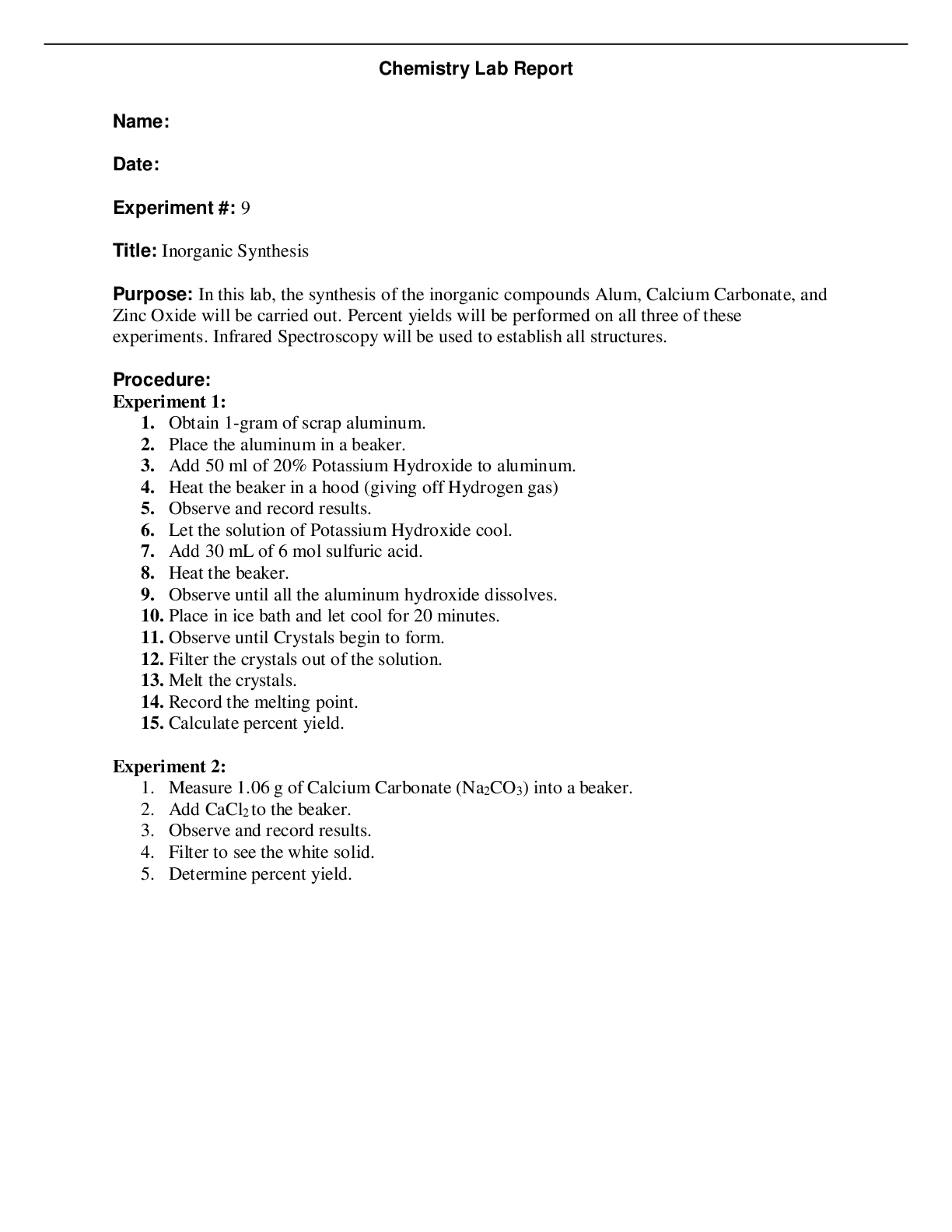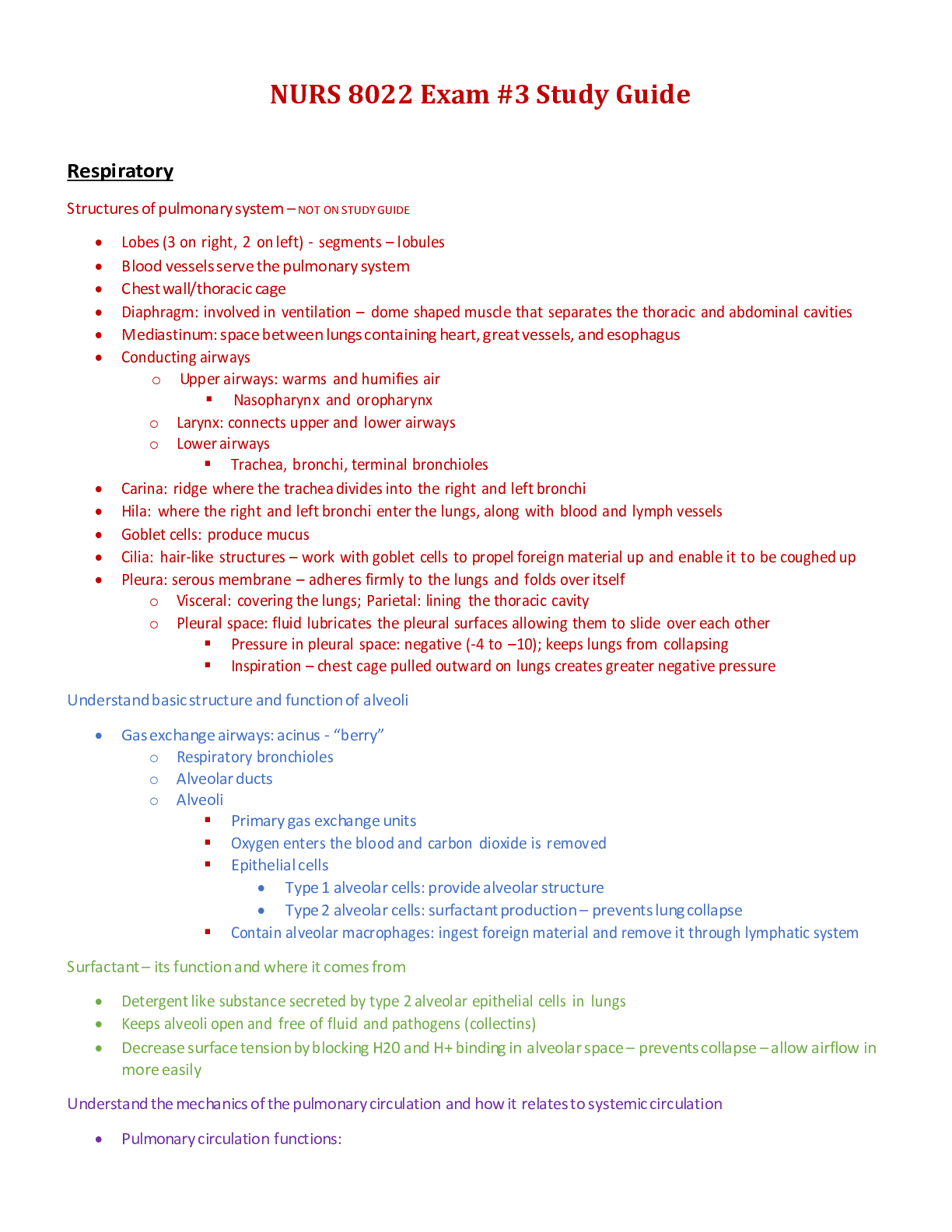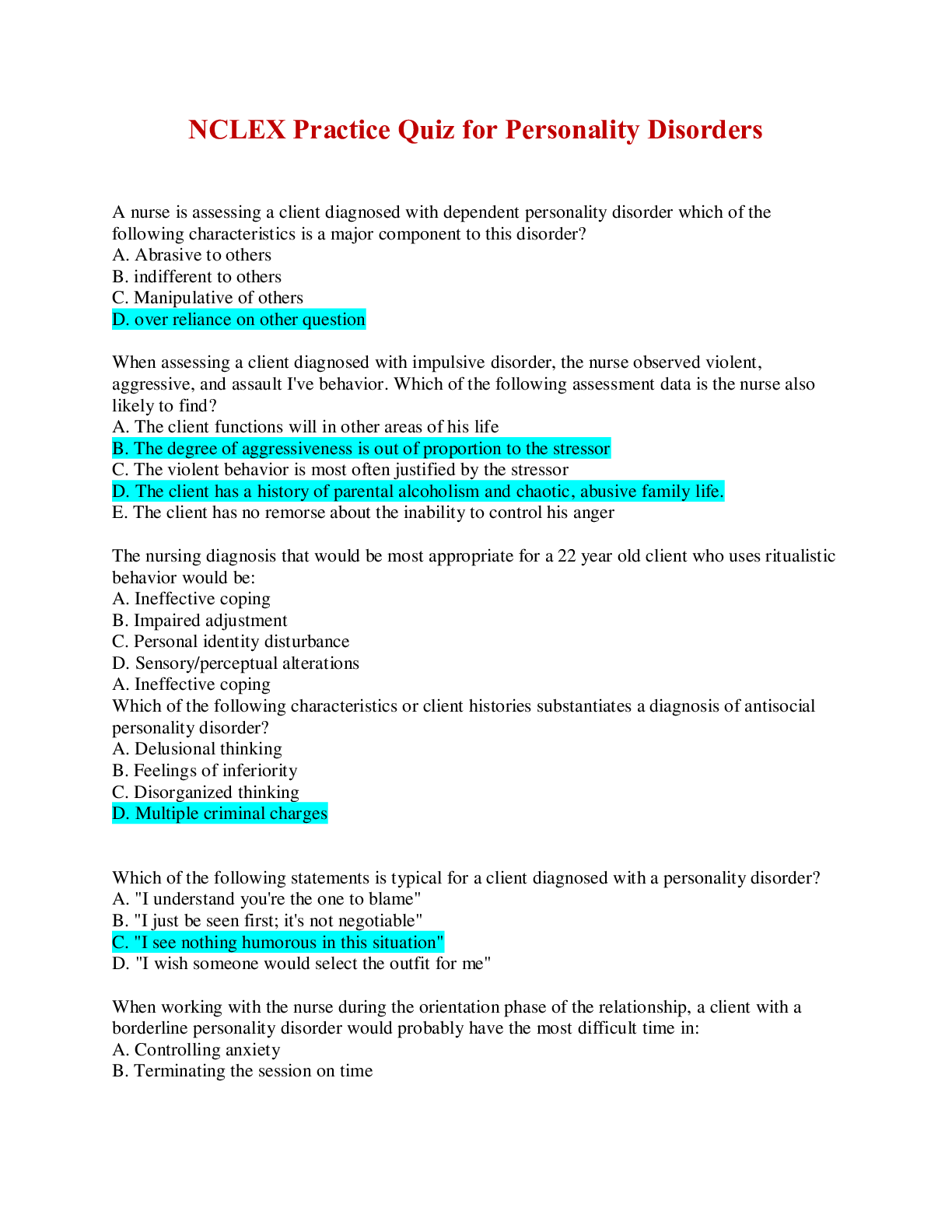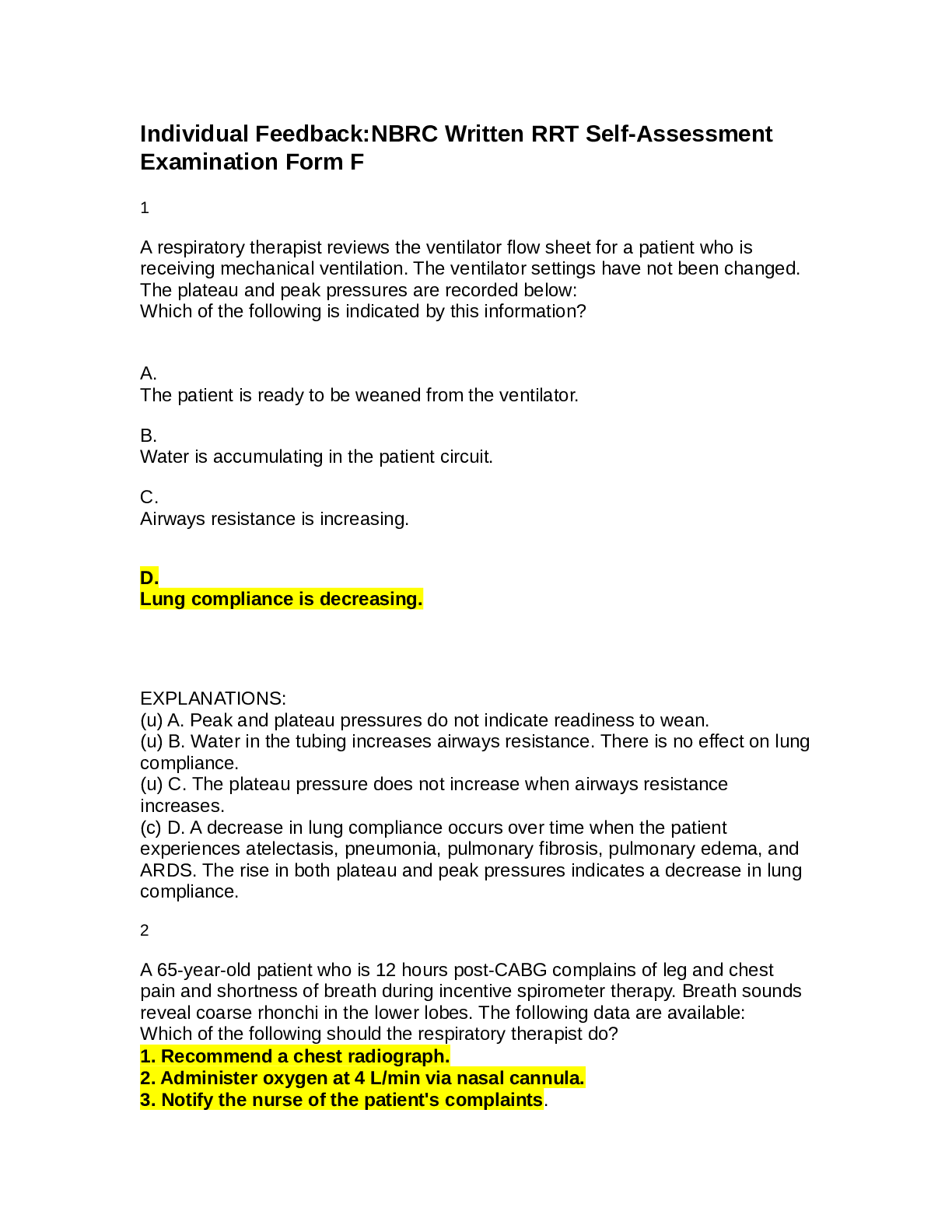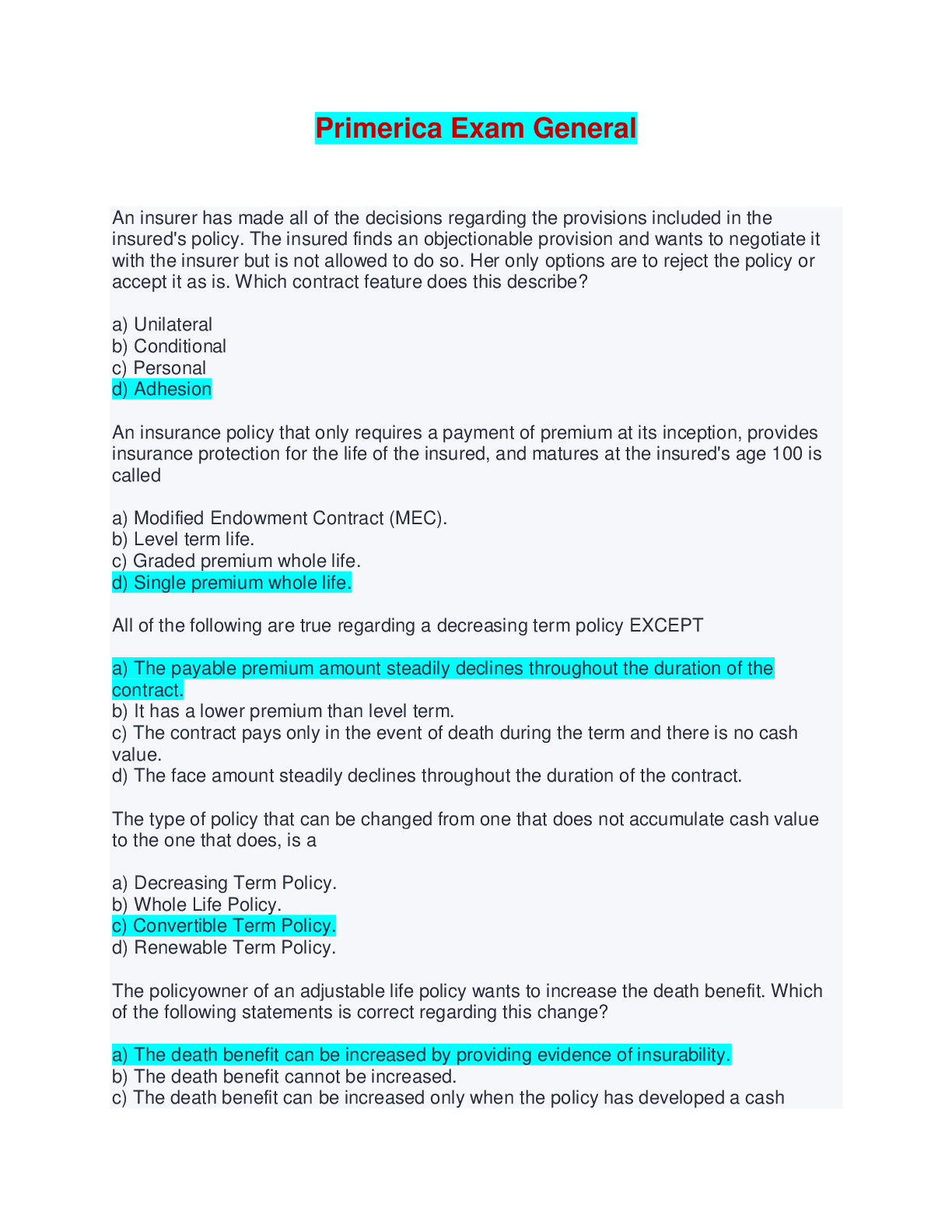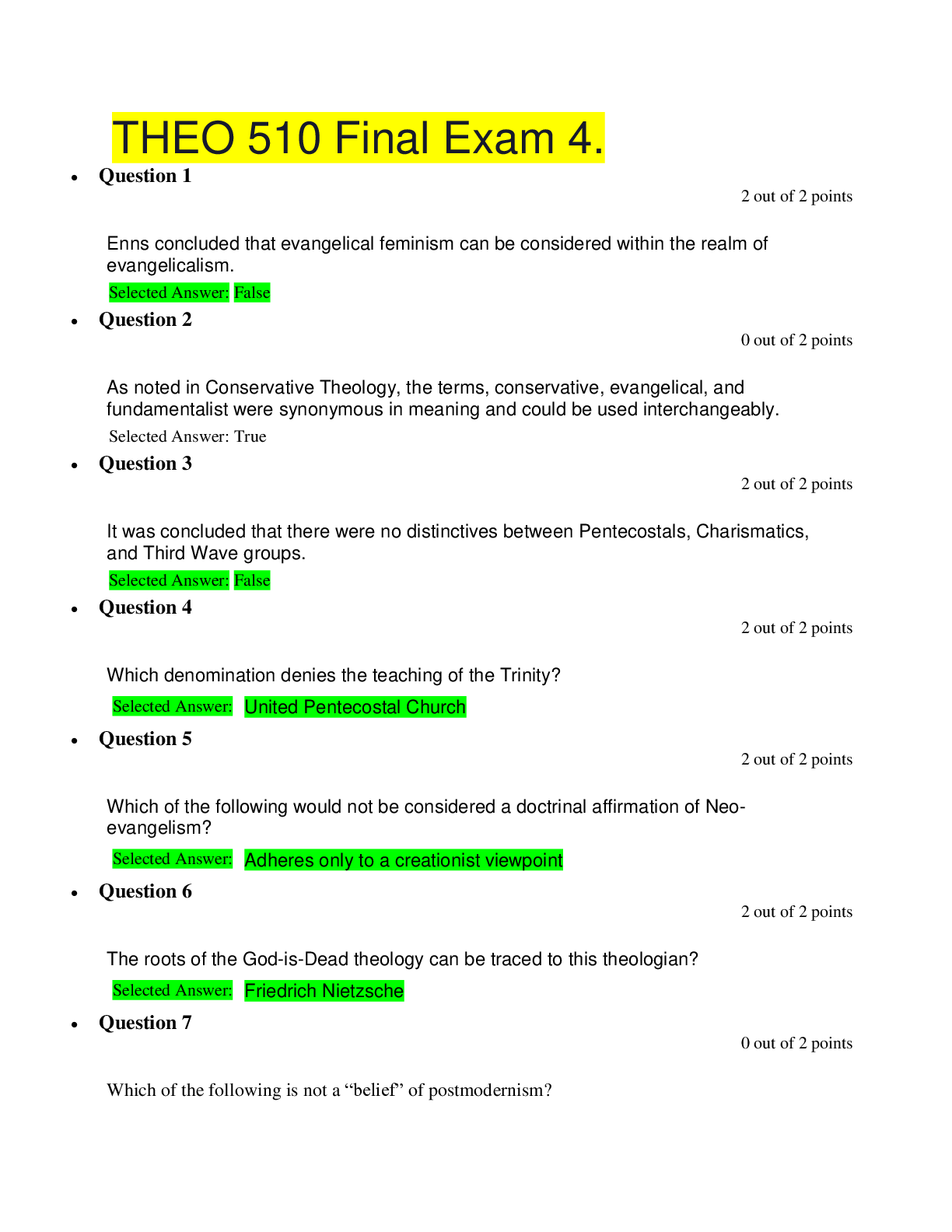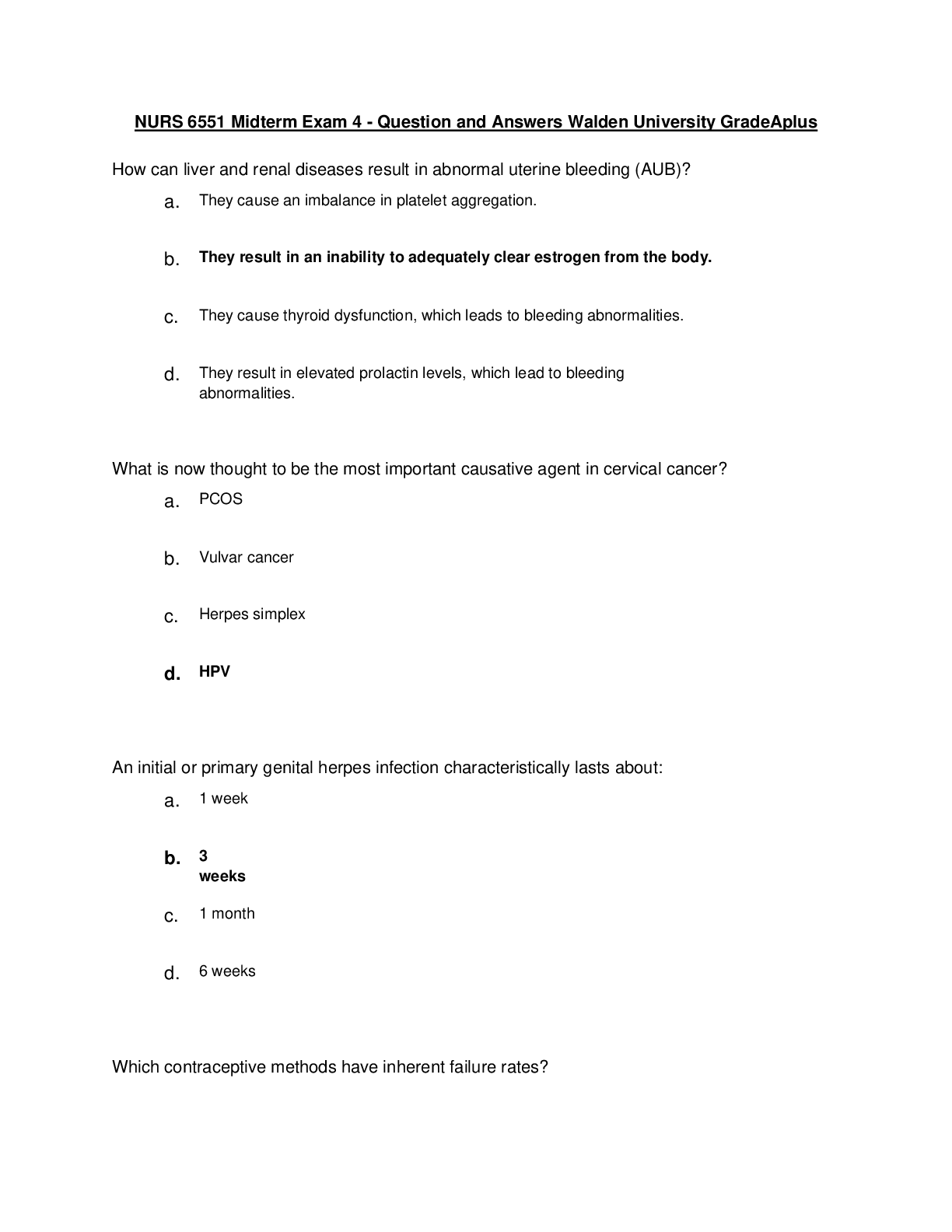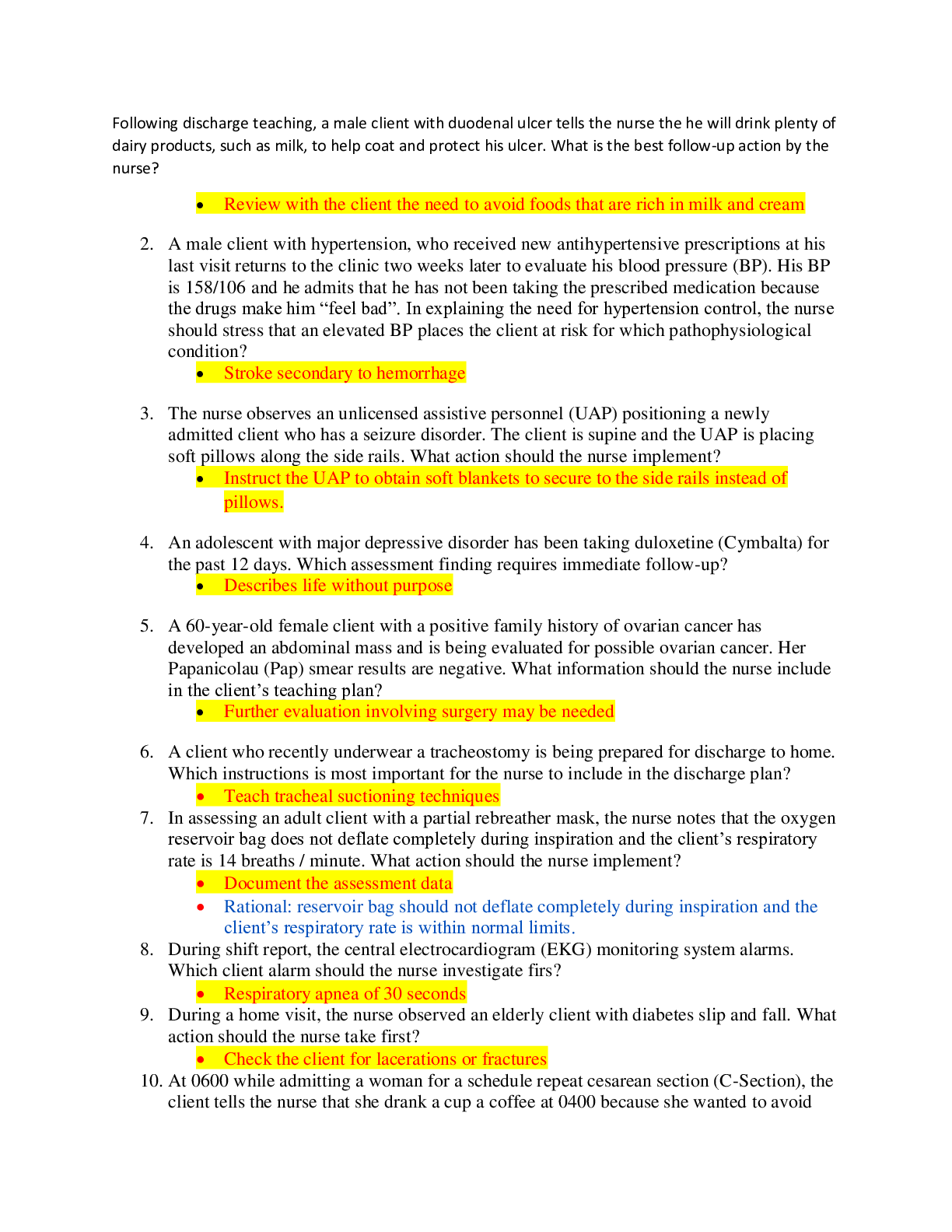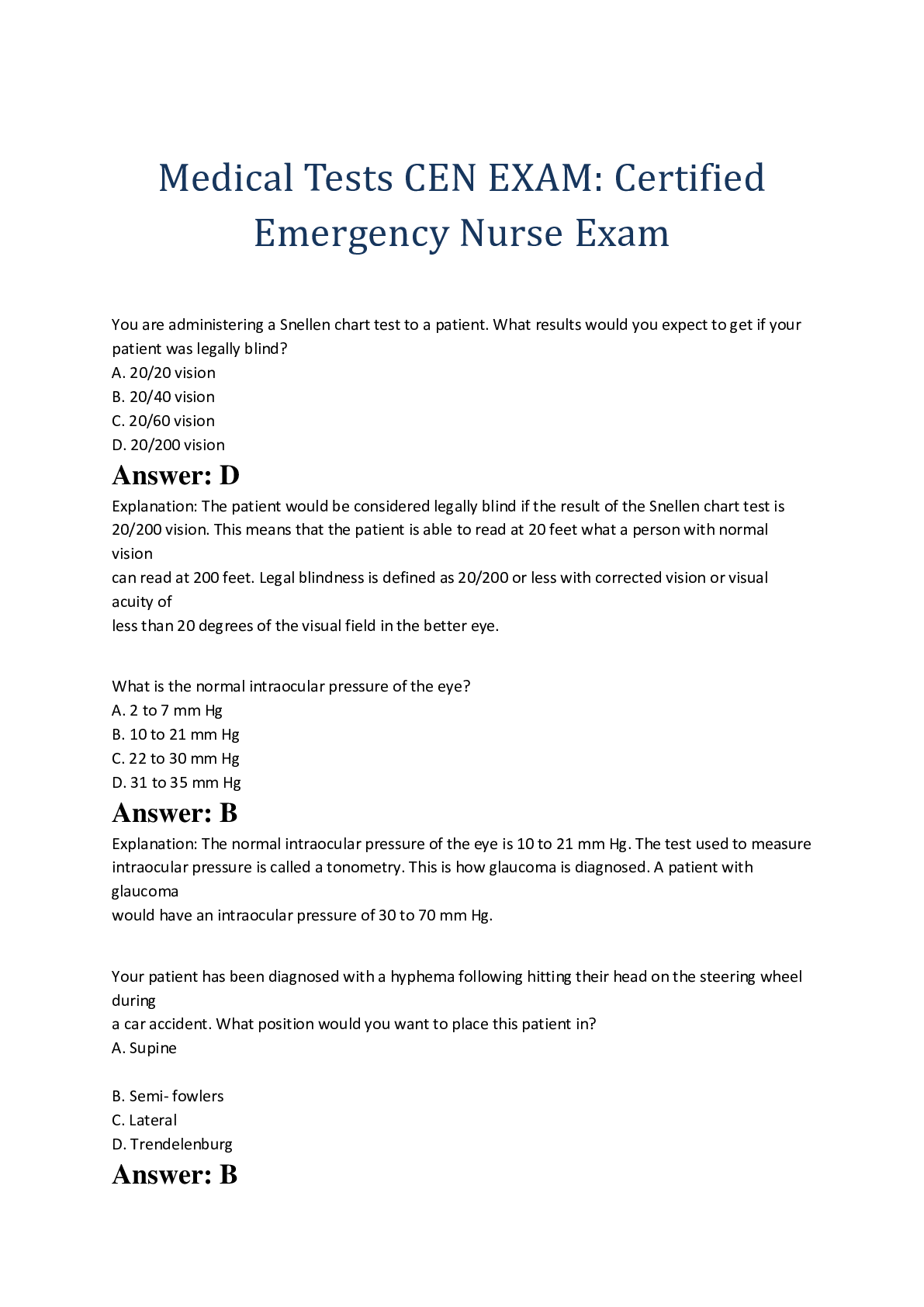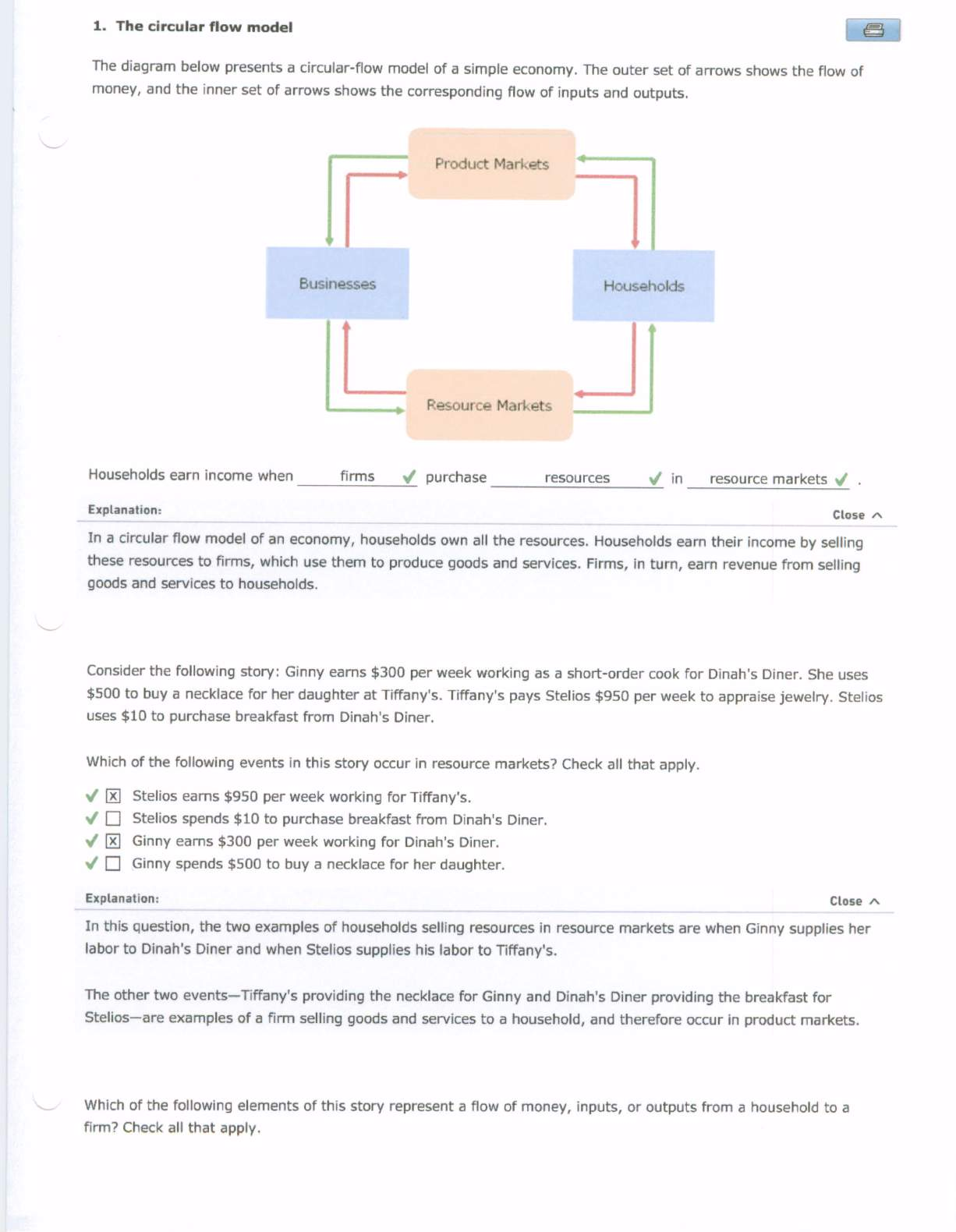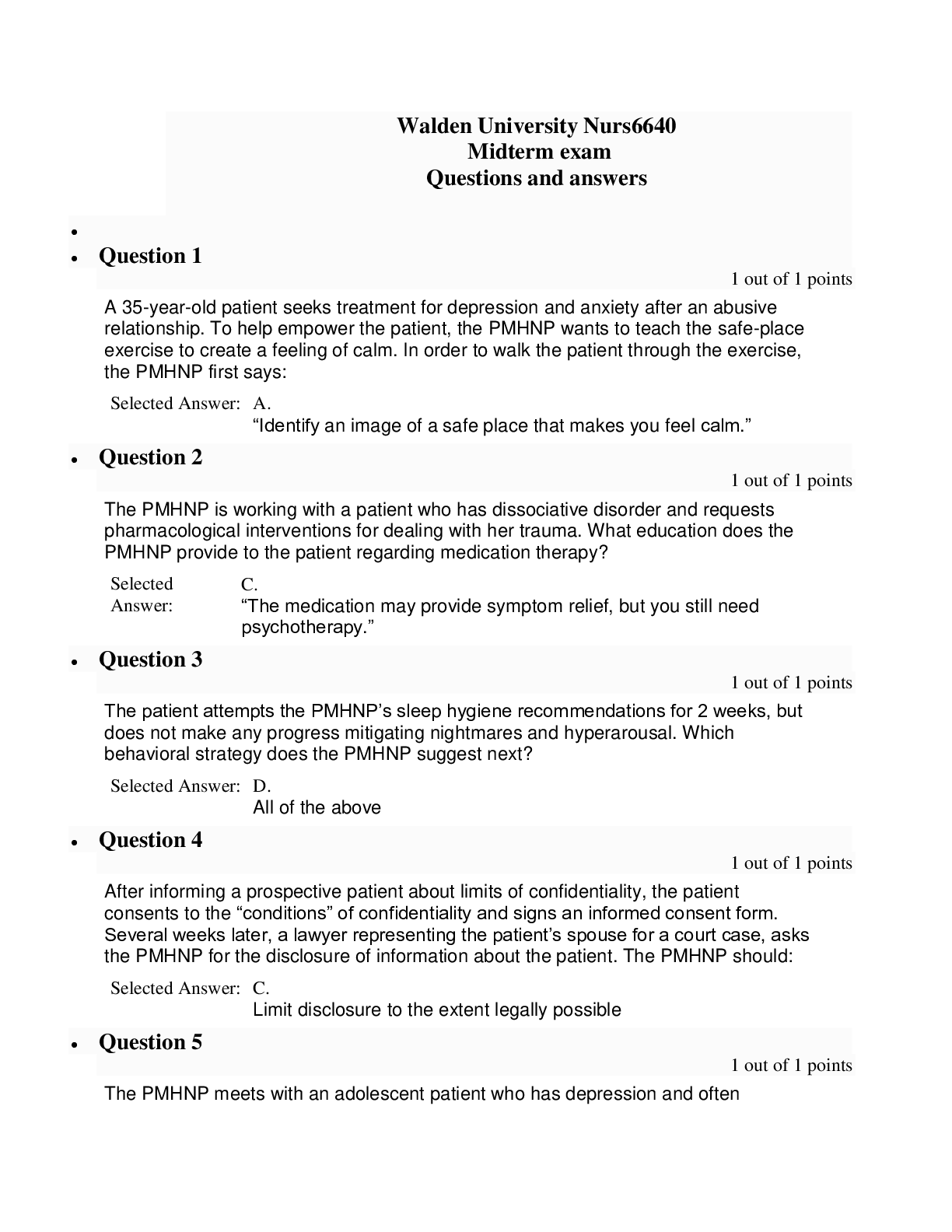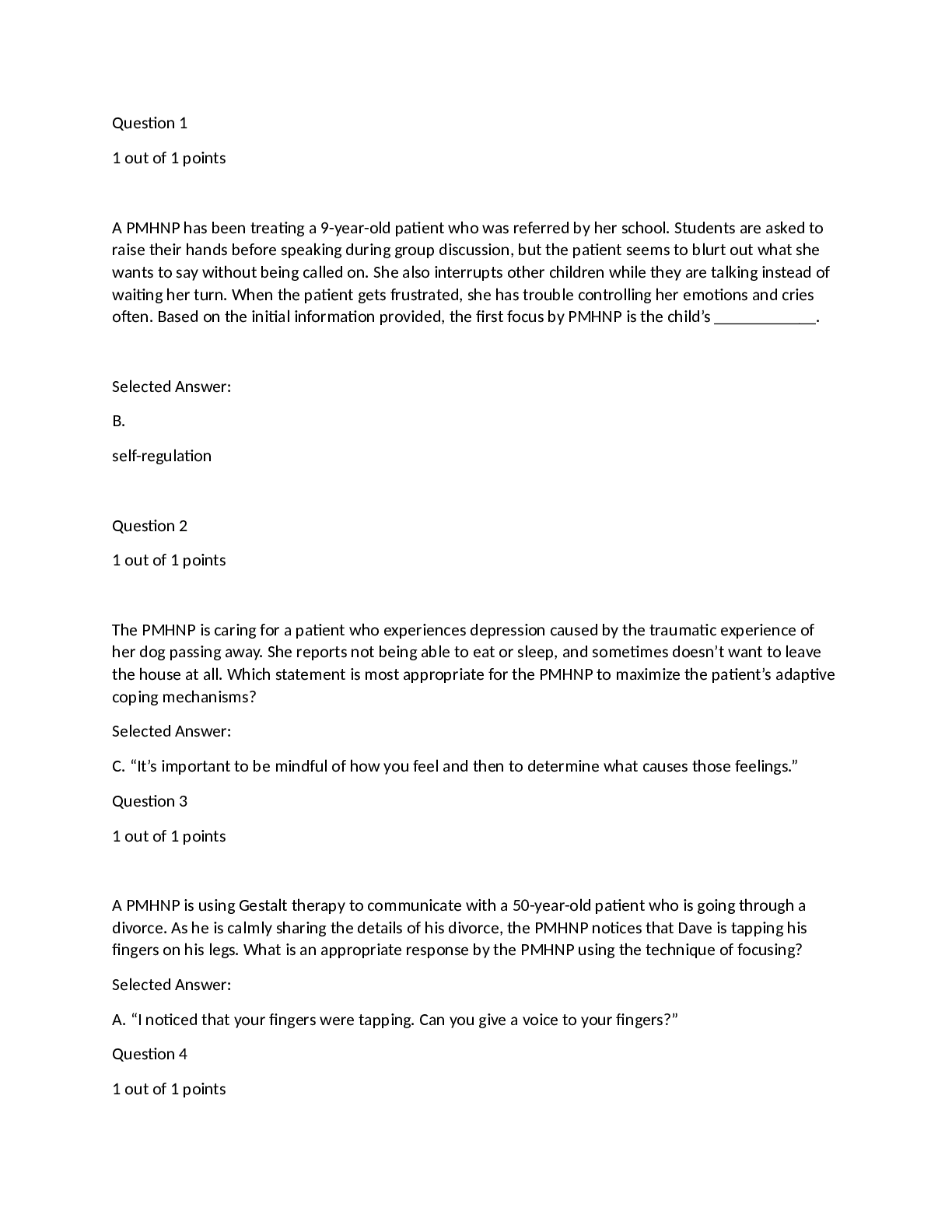Health Care > EXAM > CCE Practice Exam 4 - Questions, Answers and Rationales (All)
CCE Practice Exam 4 - Questions, Answers and Rationales
Document Content and Description Below
CCE Practice Exam 4 - Questions, Answers and Rationales In Alzheimer's disease, neuron loss occurs throughout the brain. However, the greatest loss is in which of the following areas? A. medial temp... oral lobe B. anterior parietal lobe C. medial occipital lobe D. posterior frontal lobe The medial temporal lobe includes the entorhinal cortex, amygdala, and hippocampus, which are involved in memory and are most affected by Alzheimer's disease. Functional brain imaging of a patient with mild-to-moderate Alzheimer's disease is most likely to find which of the following? A. increased metabolism in the frontal lobes and basal ganglia B. decreased metabolism in the prefrontal cortex and thalamus C. reduced metabolism in the hippocampus and entorhinal cortex D. increased metabolism in the hippocampus and amygdala Neuronal degeneration in the medial temporal structures (entorhinal cortex, hippocampus, and amygdala) has been linked to Alzheimer's disease. On a PET scan, this is manifested as reduced metabolism in these structures. Research on the effectiveness of the SSRIs has found that: A. a higher dose of an SSRI is usually required when treating OCD than when treating depression. B. a lower dose of an SSRI is usually required when treating OCD than when treating depression. C. a moderate dose of an SSRI is usually required when treating OCD but the correct dose for depression depends on the severity of symptoms. D. a moderate dose of an SSRI is usually required when treating depression but the correct dose for OCD depends on the severity of symptoms. The research on SSRI dosage is limited and not entirely consistent. However, based on their meta-analysis of the studies, H. Bloch and colleagues concluded that a higher dose is required when treating OCD than when treating depression [Meta-analysis of the dose response relationship of SSRI in obsessive-compulsive disorder, Molecular Psychiatry, 15(8), 850-855, 2010]. The National Institute of Mental Health Multimodal Treatment Study of ADHD (MTA) compared the effectiveness of four treatments - medication management alone, behavioral treatment alone, combined medication and behavioral treatment, and routine community care. The results of the initial study indicated that: A. behavioral treatment alone is as effective as medication alone. B. medication alone or behavioral treatment alone is as effective as the combined treatment. C. medication alone or the combined treatment is more effective than behavioral treatment alone or routine community care. D. behavioral treatment alone or the combined treatment is more effective than medication alone or routine community care. Of the answers given, this is the best one. The initial results (which is what this question is asking about) found that medication management alone and the combined treatment had similar effects (and better effects than behavioral treatment alone or routine community care) for alleviating the core symptoms of ADHD. However, follow-up studies found that the superiority of medication alone and the combined treatment was true for short-term effects but not long-term effects. Stead et al.'s (2012) review of the literature found that ________ is the most effective form of nicotine replacement therapy for treating cigarette smoking. A. nicotine gum B. nicotine nasal spray C. nicotine tablet/lozenge D. nicotine patch These investigators found that, of the nicotine replacement therapies, nicotine nasal spray was most effective and nicotine gum was least effective (Nicotine replacement therapy for smoking cessation, Cochrane Database Systematic Reviews, CD000146, 2012). A person with Dissociative Amnesia is unable to recall anything that happened to her during the first few hours after she was physically assaulted. As defined in the DSM, this is referred to as: A. localized amnesia. B. selective amnesia. C. anterograde amnesia. D. retrograde amnesia. The loss of memory for personal information limited to a circumscribed period of time is referred to as localized amnesia. b. Incorrect Selective amnesia refers to a loss of memory for some, but not all, events during a circumscribed period. c. Incorrect Anterograde amnesia is a general term that refers to the inability to form new memories and does describe the woman's loss of memory. However, because it does not refer specifically to memory loss associated with Dissociative Amnesia, it is not the best answer to this question. d. Incorrect Retrograde amnesia refers to a loss of memory for information already stored in long-term memory. Studies investigating the genetic contribution to major depression have found that: A. the risk for depression is significantly higher for biological offspring who have one parent with depression than for those who have two parents with the disorder. B. the risk for depression is significantly higher for biological offspring who have two parents with depression than for those who have only one parent with the disorder. C. the risk for depression is about the same for biological offspring who have either one parent or two parents with depression. D. the risk for depression is significantly higher for biological offspring who have a mother with depression than for those who have a father with depression. The studies have confirmed that having a biological parent with depression increases an offspring's risk for major depression as well as a number of other disorders. However, the risk for depression is similar regardless of whether the child has one parent or two parents with major depression. See, e.g., Lieb, R. et al., Parental major depression and the risk of depression and other mental disorders in offspring: A prospective-longitudinal community study, Archives of General Psychiatry, 59, 365-374, 2002. Because research has found low to moderate inter-rater reliability for the diagnosis of __________, there is some controversy among experts regarding its validity. A. Specific Phobia B. Generalized Anxiety Disorder C. Panic Disorder Incorrect D. Obsessive Compulsive Disorder Presence of which of the following symptoms would help confirm a DSM diagnosis of Inhalant Intoxication? A. increased appetite, dry mouth, and tachycardia B. unsteady gait, slurred speech, and tremor C. nausea, vomiting, and muscle aches D. fatigue, vivid and unpleasant dreams, and increased appetite Symptoms of Inhalant Intoxication include dizziness, nystagmus, incoordination, slurred speech, unsteady gait, lethargy, depressed reflexes, psychomotor retardation, tremor, generalized muscle weakness, blurred vision, stupor or coma, and euphoria. When shown the word "hot" a patient says "cold" and when shown the word "rock" the patient says "stone." These errors are most suggestive of: A. surface dyslexia. B. deep dyslexia. C. pure alexia. D. literal alexia. a. Incorrect Surface dyslexia is characterized by reading without comprehension due to an inability to read words that are irregularly spelled (e.g., light, sword). b. CORRECT Deep dyslexia involves several reading errors including semantic paralexia, which is characterized by the substitution of words with similar meanings (e.g., cold for hot). c. Incorrect Pure alexia is also known as "word blindness" and refers to an inability to read words, even when they have been written by the person him/herself. d. Incorrect People with literal alexia can read whole words but not individual letters. It is often difficult to distinguish between Major and Mild Neurocognitive Disorder, Delirium, and Major Depressive Disorder in older adults. However, the presence of which of the following suggests that Delirium is the appropriate DSM-5 diagnosis? A. deficits in memory B. fatigue or loss of energy C. impaired attention and awareness D. flight of ideas As described in the DSM-5, the essential feature of Delirium is a disturbance in attention and awareness plus an additional disturbance in cognition (e.g., memory deficit, disorientation, language impairment, deficit in visuospatial ability, or perceptual distortion) Following her divorce nine months ago, Melody, age 29, developed intermittent abdominal pain and frequent morning headaches. She's concerned that these symptoms mean that she has cancer or other life threatening illness, and constant worry about her health has made it difficult for her to care for her children, spend time with her friends, and concentrate at work. Assuming that a physical exam has ruled out a physical cause for her symptoms, the most likely DSM-5 diagnosis for Melody is: A. Somatoform Disorder NOS Incorrect B. Conversion Disorder with mixed symptoms C. Pain Disorder D. Somatic Symptom Disorder with predominant pain The most likely diagnosis for Melody is Somatic Symptom Disorder, which is characterized by the presence of one or more somatic symptoms accompanied by excessive thoughts, feelings, or behaviors related to the symptoms. Because her symptoms involve only pain, the specifier "with predominant pain" is appropriate. A pigeon is placed in a cage that has two levers. Lever #1 delivers reinforcement on a VI-30-second schedule, while Lever #2 delivers reinforcement on a VI-60-second schedule. What proportion of the pigeon's pecks will be on Lever #1? A. one-third B. two-thirds C. one-half Incorrect D. three-fourths In the situation described in the question, the pigeon will peck the VI-30 key twice as often as the VI-60 key. Put another way, 2/3 of the pigeon's pecks will be on the VI-30 key and the remaining 1/3 will be on the VI-60 key. Subjects in a research study are asked to read the following list of words: pin, sewing, thread, sharp, haystack, injection, point, pain. They are then asked to recall as many words from the list as possible, and many subjects recall the word "needle" even though it is not one of the words in the list. This illustrates which of the following? A. false memory induction Incorrect B. imagination inflation C. Deese-Roediger-McDermott paradigm D. Loftus misinformation effect a. Incorrect The false memory induction procedure creates false memories by repeatedly asking subjects about events they never experienced. b. Incorrect Imagination inflation involves creating false memories of an event by asking subjects to imagine the event before asking them to recall if it happened to them. c. CORRECT The Deese-Roediger-McDermott (DRM) effect refers to the tendency to erroneously recall a word from a word list that contains semantically related words. It has been used to study false memory and identify people who are prone to creating false memories. d. Incorrect The Loftus misinformation effect occurs when the original memory of an event is altered by subsequent exposure to misleading information about that event. As defined by Aaron Beck, __________ involves drawing a specific conclusion about an experience in the absence of supporting evidence for that conclusion. A. selective abstraction B. emotional reasoning C. personalization D. arbitrary inference Arbitrary inference occurs when a person draws a conclusion about an event or experience without there being corroborating evidence and/or when there is contradictory evidence. When aversive counterconditioning is being used to eliminate a fetish, the fetish object is the: A. unconditioned stimulus. B. unconditioned response. C. conditioned stimulus. D. conditioned response. The conditioned stimulus is one which is paired with the unconditioned stimulus until the former elicits the same response as the latter. In the aversive conditioning of a fetish, the fetish is paired with an unconditioned stimulus until the fetish elicits the same response (e.g., aversion) as the unconditioned stimulus. A behavioral therapist is using positive reinforcement to increase a desired behavior. After the behavior is well-established, the psychologist switches from a continuous schedule of reinforcement to an intermittent one. This technique is referred to as: A. thinning. B. fading. C. shaping. D. inoculation. Physical guidance is sometimes necessary when using _________ but must be used with caution because it can have negative consequences (e.g., can elicit aggressive or avoidance behaviors). A. aversive counterconditioning B. negative practice C. response cost D. overcorrection Physical guidance may be a necessary component of overcorrection in order to ensure that the individual engages in the positive practice that is part of this intervention. A friend asks you how you liked the concert you went to last Saturday night. As you try to recall the concert, you realize that your memory is being affected by other concerts you have attended in the past. In other words, your memory of last Saturday's concert is being affected by: A. your implicit memory of concerts. B. a lack of encoding specificity. C. positive memory transfer. D. your schema for concerts. A schema is a group or cluster of knowledge about an object or event. Your recollection of last Saturday's concert is being affected by your "cluster of knowledge" regarding concerts. In the case of Brown v. Board of Education of Topeka (1954), research by Kenneth and Mamie Clark was used to support the argument that: A. school segregation contributes to a negative self-image among African American children. B. school segregation contributes to low school achievement among African American children. C. academic underachievement of African American children is related to parental and cultural expectations. D. academic underachievement of African American children is related to low teacher expectations. In adolescence, sibling relationships usually become: A. less emotionally intense and more distant. B. less egalitarian. C. more competitive and conflictual. D. more intimate and affectionate. Reducing risk impact, reducing negative chain reactions, promoting self-esteem and self-efficacy, and providing opportunities are four techniques identified by __________ for promoting resiliency in high-risk children. A. Harlow B. Rutter C. Patterson D. Bronfenbrenner Antisocial behavior and later delinquency have been associated with: A. an authoritarian parenting style and consistent physical discipline. B. an authoritarian parenting style and inconsistent, excessive discipline. C. a laissez-faire parenting style and inconsistent warmth and concern. D. a laissez-faire parenting style and harsh, inconsistent discipline. In terms of parenting styles, adolescent antisocial behavior is most associated with which of the following? A. authoritarian B. rejecting-neglecting C. permissive D. instrumental Of the parenting styles identified by Baumrind and others, the rejecting-neglecting style is most consistent with the parenting characteristics that have been found to predict delinquency and antisocial behavior during adolescence. See the Lifespan Development chapter for additional informtion on parenting styles. A four-year old who hates strings beans gets upset when his mother cuts them into small pieces because he thinks that he now has to eat more beans. A Piagetian would describe this as an example of which of the following? A. object concept B. transduction C. irreversibility D. decentration a. Incorrect As described by Piaget, the object concept (also known as object permanence) develops during the sensorimotor stage and allows a child to recognize that objects and people continue to exist even when he/she cannot perceive them. b. Incorrect Transduction (also known as transductive and precausal reasoning) refers to the tendency of preoperational children to mentally link certain experiences, whether or not they actually have a causal relationship. c. CORRECT Irreversibility is the inability to imagine reversing a physical operation and is a factor that contributes to a preoperational child's inability to conserve. d. Incorrect Decentration is the ability to focus on more than one aspect of an object or situation at a time. It is the opposite of centration, which is one of the factors that contributes to a preoperational child's inability to conserve Research on Kohlberg's theory of moral development has found that very few people ever reach Stage 6. However, some do engage in Stage 5 reasoning and base their moral judgments on: A. social contracts. B. self-chosen universally-applicable standards. C. rules and laws. D. the motivation underlying an act. Stage 5 is the first stage in the postconventional level. People in this stage consider social contracts and democratically-chosen laws when making moral judgments. Research investigating the effects of living with a stepparent on a child's adjustment suggests that _________ age at the time of the remarriage and ______ gender are associated with fewer problems adjusting to a stepparent. A. younger; female B. younger; male C. older; female D. older; male Research investigating the effects of living with a stepparent on a child's adjustment suggests that _________ age at the time of the remarriage and ______ gender are associated with fewer problems adjusting to a stepparent. A. younger; female Incorrect B. younger; male C. older; female D. older; male Which of the following is LEAST characteristic of infants who were exposed to cocaine in utero? A. They are abnormally insensitive to tactile, visual, and auditory stimulation. B. They are excessively irritable and unresponsive to attempts to comfort. C. They often have increased motor tone. D. They often have a low birthweight and small head circumference. Studies investigating the "empty nest syndrome" have found that: A. marital satisfaction tends to decrease for middle-aged adults when all of their children leave home. B. marital satisfaction tends to increase for middle-aged adults when all of their children leave home. C. marital satisfaction tends to decrease for middle-aged men but increase for middle-aged women when all of their children leave home. D. marital satisfaction tends to decrease for middle-aged women but increase for middle-aged men when all of their children leave home. A school psychologist is trying to determine why a fourth grade student with an above-average IQ is doing poorly in school. He talks to the student's parents and teacher separately and then meets with them jointly to discuss similarities and differences in the boy's behaviors at home and school. From the perspective of Bronfenbrenner's bioecological model, the psychologist is investigating which of the following? A. microsystem and mesosystem B. microsystem and exosystem C. macrosystem and mesosystem D. macrosystem and exosystem The microsystem includes aspects of the child's environment that affect him/her directly (e.g., school and home). The mesosystem refers to the interactions between elements of the microsystem (e.g., the interaction between home and school). Wernicke's encephalopathy is due to: A. a thiamine deficiency. B. a deficiency of Vitamin C. C. acute head trauma. D. anoxia. Wernicke's encephalopathy is caused by a deficiency of thiamine, often as the result of chronic alcoholism. Additional information about this disorder is provided in the Physiological Psychology and Psychopharmacology chapter of the written study materials. Recent research using brain imaging techniques, has found that significant atrophy in the __________ distinguishes people with Alzheimer's dementia from healthy peers. A. vestibular nucleus B. hypothalamus C. entorhinal cortex D. somatosensory cortex MRIs have revealed that individuals in the early stages of Alzheimer's Dementia have a reduction in the volume of the entorhinal cortex of up to 30% when compared to healthy peers and that those in the later stages show a reduction of up to 45%. When asked to name as many different animals as possible, a patient with traumatic brain injury says, "Oh, you've got your big dogs and your little dogs, and then there's black dogs, and white dogs, and brown dogs, and I had a black and white dog once and he was really nice." The patient's response represents perseveration, which is associated with damage to which of the following? A. occipital lobe B. parietal lobe C. temporal lobe D. frontal lobe This patient is exhibiting perseveration - i.e., he is repeating "dog" rather than naming different animals. Perseveration on the category fluency test is indicative of damage in the dorsolateral area of the frontal lobe. Several subcortical structures are involved in the mediation of emotion. Studies of decorticate animals, for instance, suggest that the __________ is responsible for a violent rage response to even trivial stimuli. A. hypothalamus B. medulla C. hippocampus D. RAS [Show More]
Last updated: 3 weeks ago
Preview 5 out of 24 pages
Instant download

Loading document previews ...
Buy this document to get the full access instantly
Instant Download Access after purchase
Add to cartInstant download
Also available in bundle (1)
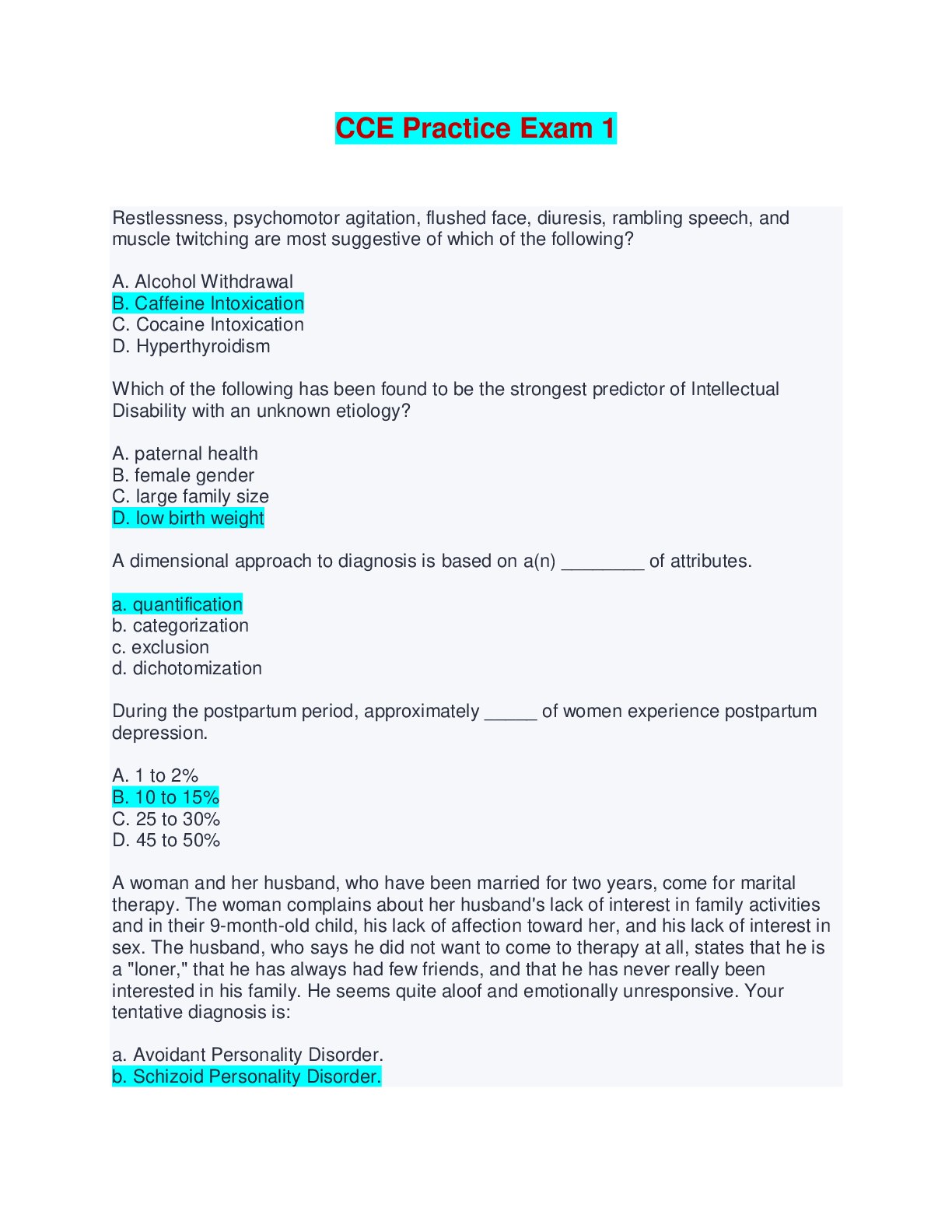
CCE PRACTICE EXAM 1 - 6 BUNDLE
CCE PRACTICE EXAM 1 - 6 BUNDLE
By Nurse Henny 2 weeks ago
$50
6
Reviews( 0 )
Document information
Connected school, study & course
About the document
Uploaded On
Jun 05, 2024
Number of pages
24
Written in
Additional information
This document has been written for:
Uploaded
Jun 05, 2024
Downloads
0
Views
18



